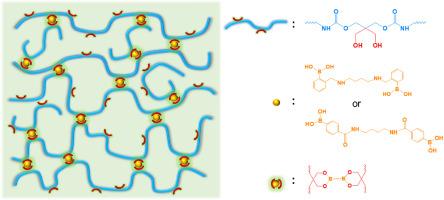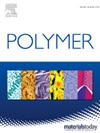聚氨酯与硼酸酯键的交联:B-N 配位的影响
IF 4.1
2区 化学
Q2 POLYMER SCIENCE
引用次数: 0
摘要
在这篇论文中,我们报告了一种利用动态硼酸酯键交联线性聚氨酯(PU)的新方法。首先,我们合成了一种线性聚氨酯,它含有大量 1,3 二醇结构单元。其次,设计并合成了两种结构相似的二硼酸,分别含有氨基和酰胺基。之后,线性聚氨酯和二硼酸之间通过生成硼酸酯键进行交联。由于发生了交联,聚氨酯网络明显改善了热机械性能,这取决于交联剂的类型。更重要的是,通过线性聚氨酯的 1,3-二醇分子和交联剂的硼酸之间的动态硼酸酯键,聚氨酯网络获得了优异的再加工和形状记忆性能。硼酸酯键的动态交换产生了再加工特性。在形状记忆特性方面,聚氨酯网络通过硼酸酯键的动态交换实现了原始形状的重编程行为。更重要的是,形状记忆特性还取决于二苯基硼酸的类型,这体现在硼酸酯键的动态差异上。对于含氨基交联剂的聚氨酯网络,硼酸酯键具有 B-N 配位。因此,硼酸酯键的动态性增大,这极大地影响了再加工性能。本文章由计算机程序翻译,如有差异,请以英文原文为准。


Crosslinking of polyurethane with boronic ester bonds: An impact of B–N coordination
In this contribution, we reported a new approach to crosslink linear polyurethane (PU) with dynamic boronic ester bonds. First, a linear PU was synthesized, which carries a plethora of 1,3-diol structural units. Second, two structurally similar diboronic acids were designed and synthesized, which contained amino and amido groups, respectively. Thereafter, the crosslinking between the linear PU and the diboronic acids was carried out via the generation of boronic ester bonds. Thanks to the crosslinking, the PU networks significantly displayed improved thermomechanical properties, contingent on types of crosslinkers. More importantly, the excellent reprocessing and shape memory properties were imparted to the PU networks, which were implemented by dynamic boronic ester bonds between 1,3-diol moieties of the linear PU and boronic acids of the crosslinkers. The dynamic exchange of boronic ester bonds is responsible for the reprocessing properties. For the shape memory properties, the PU networks featured the reprogramming behavior of original shapes via the dynamic exchange of boronic ester bonds. More importantly, the shape memory properties were also dependent on types of diphenylboronic acids, which was reflected with the difference in dynamicity of boronic ester bonds. For the PU networks with amino-containing crosslinker, the boronic ester bonds featured the B–N coordination. As a result, the boronic ester bonds had the increased dynamicity, which significantly affected the reprocessing properties.
求助全文
通过发布文献求助,成功后即可免费获取论文全文。
去求助
来源期刊

Polymer
化学-高分子科学
CiteScore
7.90
自引率
8.70%
发文量
959
审稿时长
32 days
期刊介绍:
Polymer is an interdisciplinary journal dedicated to publishing innovative and significant advances in Polymer Physics, Chemistry and Technology. We welcome submissions on polymer hybrids, nanocomposites, characterisation and self-assembly. Polymer also publishes work on the technological application of polymers in energy and optoelectronics.
The main scope is covered but not limited to the following core areas:
Polymer Materials
Nanocomposites and hybrid nanomaterials
Polymer blends, films, fibres, networks and porous materials
Physical Characterization
Characterisation, modelling and simulation* of molecular and materials properties in bulk, solution, and thin films
Polymer Engineering
Advanced multiscale processing methods
Polymer Synthesis, Modification and Self-assembly
Including designer polymer architectures, mechanisms and kinetics, and supramolecular polymerization
Technological Applications
Polymers for energy generation and storage
Polymer membranes for separation technology
Polymers for opto- and microelectronics.
 求助内容:
求助内容: 应助结果提醒方式:
应助结果提醒方式:


